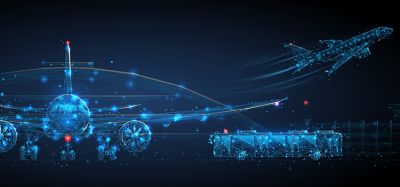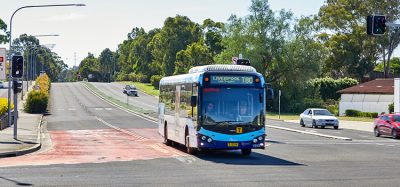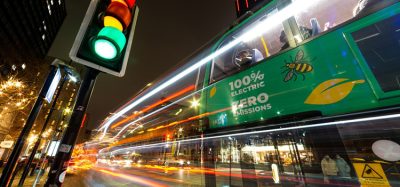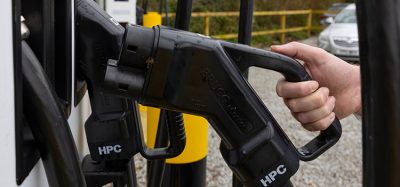Huawei’s digital revolution for a resilient and sustainable future in air travel
- Like
- Digg
- Del
- Tumblr
- VKontakte
- Buffer
- Love This
- Odnoklassniki
- Meneame
- Blogger
- Amazon
- Yahoo Mail
- Gmail
- AOL
- Newsvine
- HackerNews
- Evernote
- MySpace
- Mail.ru
- Viadeo
- Line
- Comments
- Yummly
- SMS
- Viber
- Telegram
- Subscribe
- Skype
- Facebook Messenger
- Kakao
- LiveJournal
- Yammer
- Edgar
- Fintel
- Mix
- Instapaper
- Copy Link
Posted: 17 January 2024 | Andy Bien - Huawei | No comments yet
Huawei’s vision and ambition is to build a fully connected and intelligent airport in the near future. Read Intelligent Transport’s interview with Andy Bien, the Chief Digital Officer for Global Aviation Business, Aviation and Rail BU at Huawei, to see how this vision will be fulfilled.
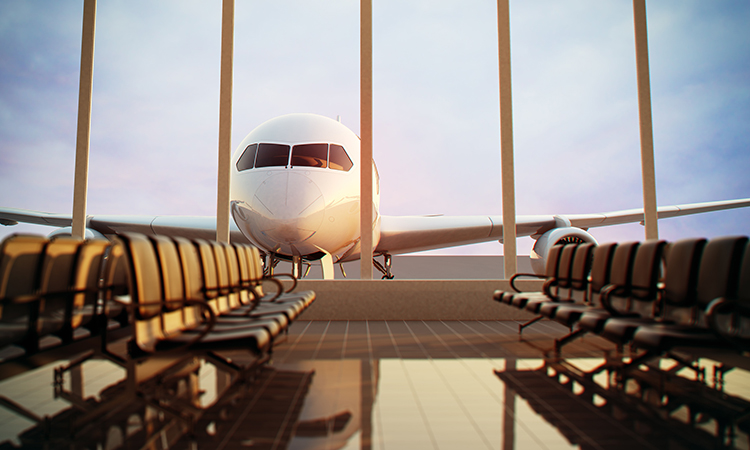

Credit: Huawei
Intelligent transport’s rapid evolution from a futuristic idea to an important necessity, particularly post-pandemic, is impacting numerous transportation modes. The urgency for digital and intelligent transformation in the transport sector is clear, driven by changing commuter travel patterns, operational complexities and an increased focus on sustainability. The European Environment Agency (EEA), in a recent report1, highlights the industry’s need for resilience and adaptability, aligning with a shift towards seamless, connected and secure travel experiences.
The International Air Transport Association (IATA), in its 2023 annual report2, notes a rise in demand for contactless solutions, emphasising technologies that enhance safety and instil passenger confidence. With commitments in place, like the International Civil Aviation Organization’s (ICAO) Long-Term Aspirational Goal to achieve net zero CO₂ emissions by 2050, sustainability is crucial. Therefore, embracing such practices not only contributes to environmental sustainability, but also offers long-term cost savings for transportation organisations. Ultimately, the urgent need for digital and intelligent transformation in intelligent transport is a vital imperative for all transportation sectors, and companies like Huawei play a pivotal role in advancing these transformative solutions.
In the aviation industry’s post-pandemic recovery, what should industry leaders focus on amid persistent losses, and how does the concept of a resilient airport connect to broader trends in transportation digitalisation?
The focus in the industry has definitely shifted from surviving to rebuilding, with a strong emphasis on sustainability. That is how Huawei will build resilience in airports. Resilience is not only the ability to withstand a one-off crisis, but also the ability to predict and adjust before crisis risks occur – prevention is key. When an event occurs, it endures the process of coping, sustaining, recovering, transforming, and adapting. In addition to overcoming numerous short-term risks, long-term challenges must also be addressed as early as possible.
Huawei proposes laying a digital intelligence foundation, which is a unified technology architecture with three layers; sensing and connectivity layer together with a digital platform on the top, in order to secure the long-term scenario applications in airports.
To be specifically leveraged by the intelligence foundation, Huawei serves the aviation industry with five end to end capabilities: full connectivity mainly for network, cloud-based service (not limited to private cloud and public cloud), data convergence and refinement, platform capability as well as intelligence application.
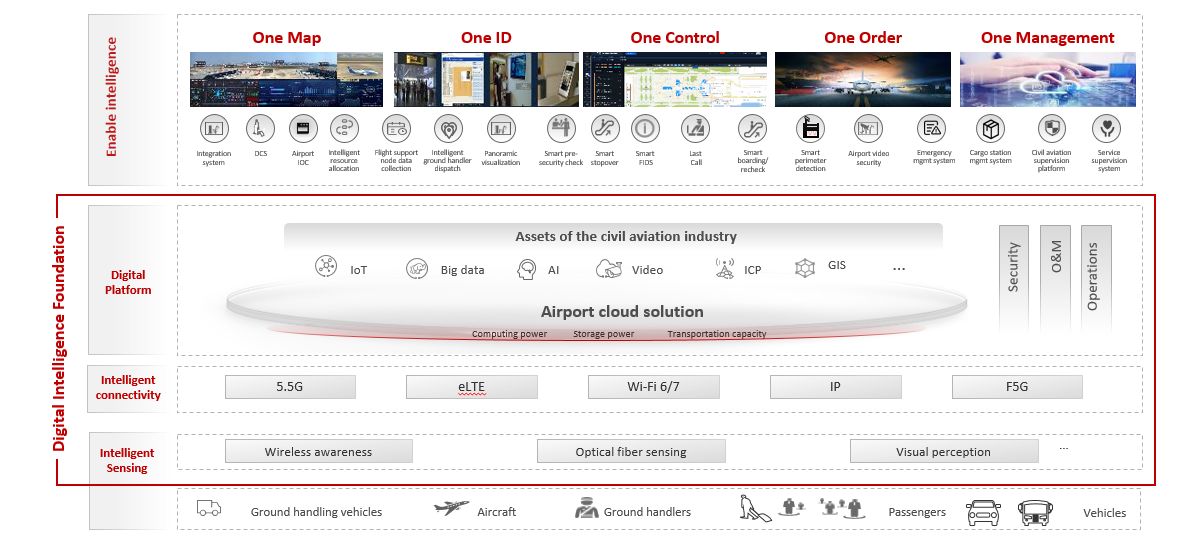

Credit: Huawei
Can you elaborate on your vision for the future of digitalised transportation, particularly in terms of design principles and how it aligns with the industry’s goals of rebuilding, resiliency, and sustainability across various modes of transport?
The future airport shall be fully connected. Huawei’s vision is to support our customers to build fully connected networks to connect all their systems and people.
Huawei believes that the future connected airport is characterised by a health and hygiene focus, increased flexibility, revenue diversification, better human experience as well as sustainability.
Health and hygiene
The industry will prioritise health and hygiene measures to reassure passengers that flying is safe. Enhanced cleaning procedures for planes and facilities, advancement of contactless processing, and initiative-taking monitoring to maintain social distancing are some example measures that would be in place for the future.
Increased flexibility
With the realisation that traffic can go up and down, the operation of both airlines and airports needs to be flexible enough to accommodate such fluctuations in terms of space usage, operating costs, and procedures. We used to believe this could only be done with a new terminal design but looking at how we coped during COVID-19, a finer and more dynamic control of people flow for both passengers and staff is necessary going forward. The concept of pay-per-use in modern cloud technology also fits this requirement very well.
Revenue diversification
The revenue model of the industry would also need to be more diverse to allow for more contributions of non-aeronautical revenue. The value of the brand which we entrust with our well-being is worth more than the cost of a plane ticket. Today, the industry is already working together to share our understanding of the paying customers’ needs and the underlying data in a manner that protects privacy and enhances security. The business model of the industry will be less reliant on transportation costs and more on value creation.
Better human experience
With the shortage of labour being one of the key challenges for recovery, a thoughtful design of the experience for both staff and passengers to maintain a less stressful and more enjoyable experience is required. A happier passenger would spend more, and a happier staff will also ensure the passenger is well cared for as well as a smoother operation.
Sustainability
With public funds being a major source to sustain the industry, and the growing threat of extreme weather affecting air travel, sustainability is now not a “nice-to-have” but a serious goal to warrant full attention. With all the member state supporting the ICAO net zero goal by 2050 for aviation published last year, all future development will need to incorporate sustainability as a necessary consideration for the goal to be realistic.
With the above changes, we can hope for a more resilient industry going forward. They are certainly challenging, but at the same time exciting, to see major changes across the areas of people, process, and technology.
With ongoing challenges in aviation’s recovery, what are your thoughts on these difficulties, and what suggestions do you have for enterprises to navigate them successfully for improved performance?
Digital transformation has been ongoing for a number of years already. A lot of initiatives, particularly on self-service passenger processing and mobile computing, have already been in place for major airlines and airports around the world. There are a few other technology trends that I feel would be vital to assist the industry in changing for the better, such as AI, data, and cloud technologies.
The development of airports is hindered by insufficient support resources, difficult operations, and a rapidly increasing workforce, which all require the digitalisation transformation.
Implementing modern technologies will mean a reliance on information consolidation and sharing, collaboration between different players – including airport management, airlines, government agencies, ground handlers, restaurants, and shops.
Huawei believes it is vital to unleash the technology potentials to renew infra by future oriented technology, to adopt unimanual technology such as data converges, cloud, AI and take digitalisation methods to improve operation, security, passenger service.
How significant a role does artificial intelligence, data and cloud technologies have in reshaping the aviation industry, and how has Huawei contributed to these areas?
Cloud
The capability to adopt different kinds of cloud services becomes new essential for the industry. There has been an acceleration of cloud adoption, particularly in the airline space. The flexibility, scalability and resilient nature of the cloud are perfect for supporting many of the changes that are required. In addition, the nature of operation outsourcing to cloud providers necessitates a change in procedure and mindset. The earlier one starts, the more ready the organisation is to benefit from the advantage of a cloud strategy.
Huawei believes universal connectivity lays a foundation for a dynamic airport. With its strong assets in data controls as well as storage, the consistent architecture means a lot which can adopt different kind cloud service like public cloud, hybrid cloud, and private cloud and meet the growing requirements of privacy and security.
Data
“The world’s most valuable resource is no longer oil, but data” (published by the Economist in 2017.) Like any other resource, it needs to be extracted, refined, used, and managed. The technology for each of these important processes is in place, and it is up to the aviation industry to make effective use of it to improve the experience, enhance efficiency and increase safety and security. The way data and humans interact has also become centre stage.
Take the example of an Intelligent Operation Centre (IOC). All relevant raw data, and processed data, can be communicated via a data integration platform. The airport operator will no longer be restricted by a lack of overview of the complicated activities happening at an airport in real-time. Data-driven decisions will be made in a timely manner which will vastly improve the organisation’s ability to manage unexpected events, be they harsh weather or a future pandemic.
Huawei’s practice with China West Airport Group (CWAG) reveals that data shall be processed with the aim of business operation. For CWAG’s operation, the processed data achieves a good forecast of the real-time status of flights, passengers, and resources, as well as promptly generating warnings, increasing ground support efficiency by 20%, and shortening the time support takes by 17%.
Connectivity
For data to find its destination, be it the cloud or other processing units, high-performance and reliable digital communication is required. Ubiquitous connectivity lays the foundation for a dynamic airport. With the complicated coordination of multiple moving objects, connectivity requires the most advanced wireless communication technology. Without such capabilities, all digital initiatives would be severely limited.
AI
With the vast amount of data generated and fed into our aviation brain continuously, do we expect humans to deal with this manufactured problem? We used to deal with these sorts of problems using automation. Then we are now able to design algorithms where the outcome is not as “predictable” as before but optimised based on the data input. This has a lot of potential where more data than any human could manage can be handled by Artificial Intelligence.
While scenario-based AI applications have been used in specific solutions such as resource allocations (and we will certainly see more of them in the near future), the potential is to help us move towards the vision of an autonomous airport/aeroplane, where the wide range of objectives of future aviation can be realised, with a controlled increase of human resources.
Could you provide examples of Huawei’s solutions implemented in aviation, along with the tangible benefits and how they align with Huawei’s vision for a fully connected and intelligent airport?
Accumulated by the allocation algorithm and OptVerse Solver, Huawei’s smart stand allocation solution helps Shenzhen Airport (SZX), one of the top airports in China be selected as IATA’s first example of the world’s new travel technology (NEXTT). For those who benefit from it, (about 2.6 million people) many can skip the shuttle bus, and the Bridge-to bridge Rate has been increased by 7% in Shenzhen Airport, one thousand/flight seat reallocation has been efficiently improved from 4 hours to 1 minute.
Huawei worked with the China West Airport Group, China’s second-largest airport management group that operates across provinces and autonomous regions, reveals that data helps forecast the status of flights, passengers, and resources. In addition to promptly generating alerts for situations requiring attention, it has also increased the efficiency of ground support by 20% and shortened reaction time by 17%.
Malaysia Airports also partners with Huawei to improve its network and applies Huawei’s Fully Connected Fiber Network to help Kuala Lumpur International Airport (KLIA) resolve all of its pain points such as poor reliability and scalability during digital and intelligent transformation, laying a connectivity foundation for it to make the move from Airports 2.0 to Airports 4.0.
How does Huawei see its technology shaping the future of aviation, and what aspects of Huawei’s vision are key to advancing the industry, particularly in terms of digitalisation and connectivity?
A post-COVID-19 aviation industry poses more challenges than before with the improved performance with limited resources applied in a sustainable manner. But the advancement of technology has lent a helping hand to not only solve those problems but reimagine a future for the industry that has yet to be defined. Now it is not a question of whether the cloud should be used, but how best to use a combination of public cloud on the one hand and cloud edge processing on the other. The key focus now is to engage with these possibilities. By understanding the relationship between humans and machines, these possibilities can be harnessed and bring real value to the industry. A new opportunity awaits.
References
- https://www.eea.europa.eu/en/newsroom/news/digitalisation-can-support-shifting-to-more-sustainable-transport-in-europe
- https://www.iata.org/contentassets/c81222d96c9a4e0bb4ff6ced0126f0bb/annual-review-2023.pdf
Andy Bien is the Chief Digital Officer for Global Aviation Business, Aviation and Rail BU at Huawei. He was the former Chief Information Officer of the Hong Kong Airport Authority, with 40 years of ICT and management experience and 20 years in the airport industry. He was responsible for strategic technology planning and execution at Hong Kong International Airport.
His focus was on advancing airport technology in several key areas, including biometrics, mobile and self-service technology, robotics, autonomous vehicles, artificial intelligence and digital twin; enabled by smart infrastructure, including the enterprise analytics platforms, hybrid cloud infrastructure, IoT platforms, future wireless platforms including WiFi 6, and an enterprise 5G infrastructure across the entire airport island.
In his current role, Andy continues to focus on the area of future connectivity, green aviation and AI applications in the industry.
Related topics
Artificial Intelligence, COVID-19, Intelligent Transport Systems (ITS), Passenger Experience, Sustainable Urban Transport
Related modes
Aviation
Related cities
Kuala Lumpur, Shenzhen
Related organisations
China West Airport Group (CWAG), European Environment Agency (EEA), Huawei, International Air Transport Association (IATA), International Civil Aviation Organization (ICAO), Kuala Lumpur International Airport (KLIA), Malaysia Airports, Shenzhen Airport (SZX)
Related people
Andy Bien




